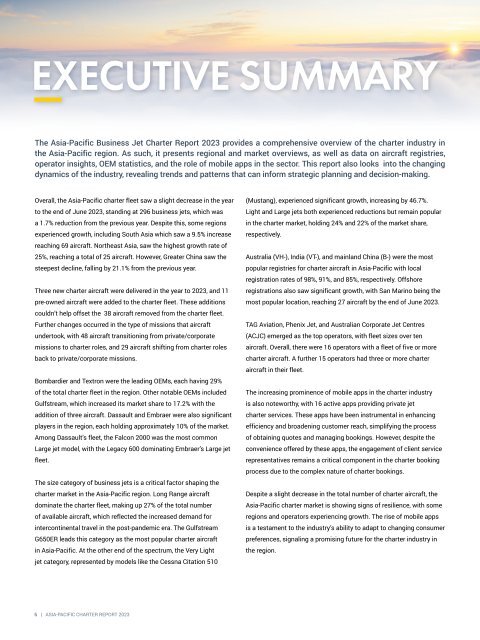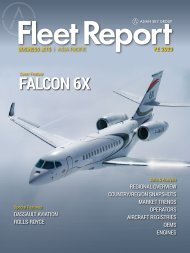Create successful ePaper yourself
Turn your PDF publications into a flip-book with our unique Google optimized e-Paper software.
EXECUTIVE SUMMARY<br />
The Asia-Pacific Business Jet <strong>Charter</strong> <strong>Report</strong> <strong>2023</strong> provides a comprehensive overview of the charter industry in<br />
the Asia-Pacific region. As such, it presents regional and market overviews, as well as data on aircraft registries,<br />
operator insights, OEM statistics, and the role of mobile apps in the sector. This report also looks into the changing<br />
dynamics of the industry, revealing trends and patterns that can inform strategic planning and decision-making.<br />
Overall, the Asia-Pacific charter fleet saw a slight decrease in the year<br />
to the end of June <strong>2023</strong>, standing at 296 business jets, which was<br />
a 1.7% reduction from the previous year. Despite this, some regions<br />
experienced growth, including South Asia which saw a 9.5% increase<br />
reaching 69 aircraft. Northeast Asia, saw the highest growth rate of<br />
25%, reaching a total of 25 aircraft. However, Greater China saw the<br />
steepest decline, falling by 21.1% from the previous year.<br />
Three new charter aircraft were delivered in the year to <strong>2023</strong>, and 11<br />
pre-owned aircraft were added to the charter fleet. These additions<br />
couldn’t help offset the 38 aircraft removed from the charter fleet.<br />
Further changes occurred in the type of missions that aircraft<br />
undertook, with 48 aircraft transitioning from private/corporate<br />
missions to charter roles, and 29 aircraft shifting from charter roles<br />
back to private/corporate missions.<br />
Bombardier and Textron were the leading OEMs, each having 29%<br />
of the total charter fleet in the region. Other notable OEMs included<br />
Gulfstream, which increased its market share to 17.2% with the<br />
addition of three aircraft. Dassault and Embraer were also significant<br />
players in the region, each holding approximately 10% of the market.<br />
Among Dassault’s fleet, the Falcon 2000 was the most common<br />
Large jet model, with the Legacy 600 dominating Embraer’s Large jet<br />
fleet.<br />
The size category of business jets is a critical factor shaping the<br />
charter market in the Asia-Pacific region. Long Range aircraft<br />
dominate the charter fleet, making up 27% of the total number<br />
of available aircraft, which reflected the increased demand for<br />
intercontinental travel in the post-pandemic era. The Gulfstream<br />
G650ER leads this category as the most popular charter aircraft<br />
in Asia-Pacific. At the other end of the spectrum, the Very Light<br />
jet category, represented by models like the Cessna Citation 510<br />
(Mustang), experienced significant growth, increasing by 46.7%.<br />
Light and Large jets both experienced reductions but remain popular<br />
in the charter market, holding 24% and 22% of the market share,<br />
respectively.<br />
Australia (VH-), India (VT-), and mainland China (B-) were the most<br />
popular registries for charter aircraft in Asia-Pacific with local<br />
registration rates of 98%, 91%, and 85%, respectively. Offshore<br />
registrations also saw significant growth, with San Marino being the<br />
most popular location, reaching 27 aircraft by the end of June <strong>2023</strong>.<br />
TAG Aviation, Phenix Jet, and Australian Corporate Jet Centres<br />
(ACJC) emerged as the top operators, with fleet sizes over ten<br />
aircraft. Overall, there were 16 operators with a fleet of five or more<br />
charter aircraft. A further 15 operators had three or more charter<br />
aircraft in their fleet.<br />
The increasing prominence of mobile apps in the charter industry<br />
is also noteworthy, with 16 active apps providing private jet<br />
charter services. These apps have been instrumental in enhancing<br />
efficiency and broadening customer reach, simplifying the process<br />
of obtaining quotes and managing bookings. However, despite the<br />
convenience offered by these apps, the engagement of client service<br />
representatives remains a critical component in the charter booking<br />
process due to the complex nature of charter bookings.<br />
Despite a slight decrease in the total number of charter aircraft, the<br />
Asia-Pacific charter market is showing signs of resilience, with some<br />
regions and operators experiencing growth. The rise of mobile apps<br />
is a testament to the industry’s ability to adapt to changing consumer<br />
preferences, signaling a promising future for the charter industry in<br />
the region.<br />
5 | ASIA-PACIFIC CHARTER REPORT <strong>2023</strong>
















